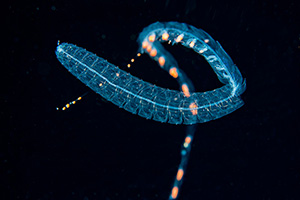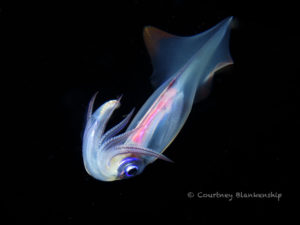An entirely new cast of characters comes to life at night on the reef. Night diving feels mysterious. Sounds are amplified, and you can only see as far as the end of your torch beam. But unlike typical night dives, wherein you’ve got the reef as reference, blackwater dives often take place in open ocean. This relatively new practice has become extremely popular in recent years. Suspended in the pitch black at a shallow depth and usually tethered to a boat line, the diver hovers over an abyssal point in the ocean, whether a trench or a drop off. In the dark sea, the sensational, alien-like creatures of the deep rise to the surface to feed and breed. Here are a few of our picks for the world’s best blackwater dives.
Singer Island, Florida
During the summer and fall, divers on Florida’s east coast can participate in a blackwater drift dive in the warm Gulf Stream Current. Divers hover in 20 feet (6 m) of water over a depth of 400 feet (170 m), witness to the planet’s largest migration — the nightly diurnal migration wherein a spectacular array deep-ocean micro creatures rises from the depths searching for food. Billions of zooplankton, bioluminescent creatures, jellyfish, squid and more will appear. Anything from dolphins to tiny fluorescent eels is possible, however.
Pico Island, Azores, Portugal
The Azores is best known for its megafauna, such as whales, sharks and mobula rays. Yet in the last year, some of the world’s best blackwater diving has taken off, especially on the island of Pico. Due to the island’s location on the Mid-Atlantic Ridge, the waters drop suddenly to 10,000 feet (3,000 m). Divers will take a Zodiac ride of around an hour out to the ridge, where they’ll drop into the water on a tethered line.
Suspended over the drop-off, where borders change suddenly from 3,300 feet (1,000 m) to 6,600 feet (2,000 m), divers can expect to see plenty of creatures from the mesopelagic zone including comb jellyfish, salps (barrel-shaped planktonic tunicates) and mauve stinger jellyfish. In a spot famous for sperm whales and giant squid, divers should listen for the sonic clicks of the giant toothed whale, and a blue or mako shark may appear as well.
 Palau
Palau
Eight nautical miles (15 km) from the coast of Palau, the dive boat will stop over 3,300 feet (1,000 m) of water. The dive team will lower a specially constructed metal bar with space for all divers to hang on. The divers are instructed to wait for half an hour before descending as underwater beams are turned on to attract some of the Pacific’s weirdest and most wonderful creatures.
Pelagic nudibranchs, as well as clear and reflective animals like the chascanopsetta prorigera, a type of deep-water flounder, are fascinating for photographers as it’s possible to see the creature’s anatomy. Pufferfish, pelagic squid, ctenophores, pelagic gastropods and pelagic cephalopods all make Palau’s blackwater diving a must-do.
Oban, Hebrides, Scotland
Dive operators in the Hebrides Islands in Scotland are pioneers of blackwater diving in the U.K. Using a 25,000-lumen floodlight, divers can easily see the creatures of the deep. Hanging from a 40-foot (10 m) line over deep Atlantic trenches, even in summer months the Scottish waters can be frigid, reaching maximum temperatures of 55 F (13 C). One of the highlights of blackwater dives in Oban are the juvenile langoustines, also known as Norway lobsters, with their tiny pincers and forked tails.
 Bay Islands, Honduras
Bay Islands, Honduras
Known for its pristine reefs, Roatan is home to some of the best blackwater diving in the world. With water that plummets to depths of 10,000 feet (3,000 m) two miles (3.5 km) from shore, prepare to witness lots of gelatinous jellyfish species with flashing bioluminescence, larval eels and siponophores. Roatan’s waters are also famous for the larval billfish, a minuscule version of a marlin. Many of these creatures feed on the zooplankton that also rises from the depths each night here, just as in Florida. On previous blackwater excursions in Roatan, divers have seen silky sharks and it’s possible to spot larger marine species as well, including mantas and larger billfish.
 Kona, Hawaii
Kona, Hawaii
Perhaps the most famous of the world’s best blackwater dives is the “Pelagic Magic” experience in Kona, Hawaii. Groups of up to six divers are tethered to the boat in around 50 feet of water, two miles (3.5 km) off the coast in 2,000 feet (600 m) of water. Divers have seen everything from minuscule seahorses to octopus and tiny fish trapped inside jellyfish. All creatures exhibit predominantly blue and green bioluminescence for mating, hunting and defense purposes. Divers can combine the blackwater dive in Kona with the world-famous manta night dive as well.









